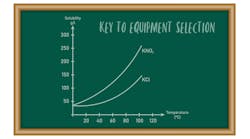Chemical engineering is the art of producing a material economically. That last word distinguishes us from chemists. Now don’t get me wrong, chemists come up with innovations and sometimes can offer great ideas on how to improve a process. Moreover, their ability to optimize crystallization and make a product with few impurities gives us a clear goal and helps define what can be manufactured on a larger scale.
[pullquote]
Unfortunately, the steps taken by the chemist may require more time, induce product changes and involve much more expensive equipment than the product’s profit margin can sustain. Also, scale-up may result in a different physical or chemical form. We can’t build a plant based on hundreds of Buchner funnels and being close to the Hoover Dam to run a filtration process. However, working with the chemist to identify the physical properties and extrinsic conditions that control the various steps in the process can convert the laboratory findings into a meaningful process design. Dozens of examples cross my mind, but the following illustrates how talking to the chemist can result in a practical and economical design.
[callToAction ]
Our laboratory had developed a new chemical for use in a consumer product. The chemists could grow the product to as large as 500 micron — but this could take 20–30 hours. In about 6–8 hours, they could get to about 100 micron. We expected some attrition in the real world and the crystallizer would utilize the fine particles. However, our customer wouldn’t tolerate the amount of dust created during drying and post-drying handling. (That firm was sensitive to having any dusty material handled by consumers.) Fortunately, we looked into this product’s physical properties, such as clumping, flowability and agglomeration. During this evaluation, we discovered the material clumps easily. Normally, this would be taken as a negative for most final products but we turned it into an advantage. After a few more discussions and experiments by our chemists, we looked at four alternative routes:
1. Crystallize to 50 micron, filter and wash to remove impurities, and then extrude to 200 micron. Drying produced very little dust.
2. Feed the wet cake from the previous route into a granulating fluid-bed dryer to get a 100-micron particle with a slightly wider particle size distribution (PSD).
3. Dry the wet cake in a flash dryer and then spheronize the fine particles to about 100 micron in a tilted-pan dryer with water added back to agglomerate the particles.
4. Crystallize to 100 micron, filter, wash and dry as originally planned, but use the fines from downstream processing as seeds for the crystallizer. This reduced the crystallization time to less than 2 hours.
With these routes defined, we could evaluate the unit operations, which also allowed us to supply product samples to our customer, and price the project. This provided confidence that full-scale operations would meet the customer’s long-term goals.
Always remember there’s no universal formula for the best solids route like there is for liquid processes. Moreover, as the above example highlights, finding the most economical solution often depends upon evaluation of physical properties.
With solids processing, you must perform several crucial steps for the scale-up and design of any new process and before significantly modifying an established one. The first is to establish the basic process route and evaluate alternatives as illustrated above. Next, you must define required product properties such as PSD, stickiness, flowability, dustiness and ease of solubility. Ignoring that latter point has caused grief many times when making a “minor” process change. Basic filtration and drying data often are overlooked as product properties; this can lead to a lot of extra work in assessing the various dryer choices. Obtaining single-particle drying kinetics and using models to evaluate a wide range of dryers can simplify the selection. Another often-overlooked factor in the planning of experiments with solids is temperature sensitivity, especially for polymorphs. This is an area in which chemists shine because they have the tools to identify polymorphs and solvates. With molecular models available, they can propose and later validate these chemicals.



